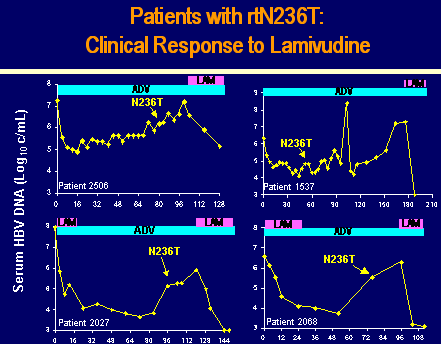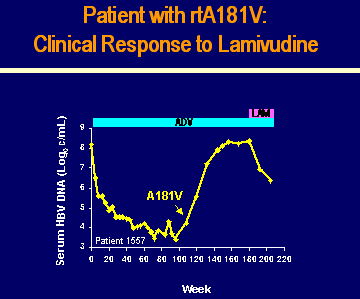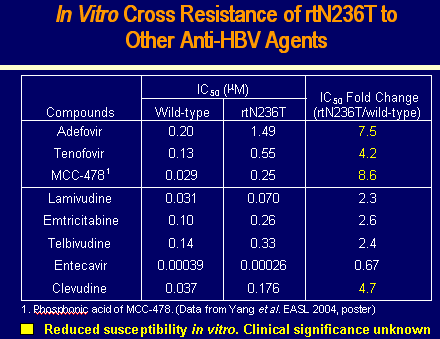 |
 |
 |
| |
Long-Term Incidence of Adefovir Resistance in Chronic Hepatitis B Patients after 144 weeks of Therapy
|
| |
| |
Reported by Jules Levin
X. Qi (Gilead Sciences, Foster City CA, USA) reported on the results of this study at the EASL Conference (April 2004, Berlin Germany). Here is his report.
Lamivudine and adefovir (ADV) demonstrate distinct resistance profiles. Lamivudine resistance emerges rapidly at a high rate: 24% at 1yr, 42% at 2 yrs, 53% at 3 yrs, and 70% at 4 yrs. Adefovir resistances emerges slowly and infrequently: 0% at week 48, <2% developed rtN236T at week 96 (Yang et al AASLD 03), and <1% developed rt181V at week 96 (Yang et al AASLD 03). The objective of this study is to determine the incidence of ADV resistance mutations.
Brief summary. the authors conclude: ADV resistance is delayed and infrequent. rtN236T and rtA181V mutations are shown to be associated with resistance to ADV with a cumulative probability of 3.9% over 144 weeks. In vitro and preliminary data suggest that the rtN236T and rtA181V mutants remain susceptible to lamivudine, Emtricitabine, LDT (Telbivudine), and Entecavir. Entecavir and LDT are in phase III studies. This suggests that patients developing ADV resistance may be successfully treated with these drugs. Reduced replication fitness was observed for rtN236T mutant HBV in vitro (Yang et al, EASL 04 poster #383).
PATIENT POPULATION
ADV treated patients from 5 clinical trials
|
Patient
|
Week 48
|
Week 96
|
Week 144
|
|
Total
|
629
|
293
|
167
|
|
Treatment Naïve
|
498 (79%)
|
149 (51%)
|
91 (54%)
|
|
LAM-resistant
|
131 (21%)
|
144 (49%)
|
76 (46%)
|
METHODS
HBV RT domain was sequenced for samples with detectable serum HBV DNA by Roche Amplicor PCR at BL, wk48, 96, and 144. (detectable=>1,000 copies/ml for week 96 and 144 samples; >400 copies/ml for week 48 samples).
Phenotypic analysis of conserved site mutations: site directed mutagenesis (wk 48); patient derived HBV clones (wks 96 and 144).
The cumulative probability of ADV resistance was calculated using the Life Table method: to capture all ADV resistant patients regardless of early termination from clinical studies.
GENOTYPING RESULTS
|
ADV-associated
|
Wk 0-48
|
Wk 0-96
|
Wk 97-144
|
|
Mutation
|
n=629
|
n=293
|
n=167
|
|
rtN236T
|
0
|
4
|
2
|
|
rtA181V
|
0
|
2
|
1
|
|
TOTAL
|
0
|
6
|
3
|
All patients who developed ADV resistance mutations (rtN236T or rtA181V) were on ADV monotherapy.
Other conserved site mutations were not shown to be associated with reduced susceptibility to ADV in vitro nor serum HBV DNA rebound in patients.
In Vitro Phenotyping and Clinical Results
|
ADV-associated Mutation
|
Patients
|
Serum HBV DNA Rebound
|
ADV IC50 Fold x fr BL
|
|
rtN236T
|
6
|
6/6
|
3.9 to 13.8
|
|
rtA181V
|
3
|
2/3
|
2.5 to 3.0
|
PATIENTS with rtN236T: clinical response to Lamivudine
After rtN236T is identified HBV DNA increases but decreases after lamivudine therapy.
|
|
| |
| |
 |
|
| |
| |
PATIENT WITH rtA181V: clinical response to lamivudine
Similar response, after mutation is identified HBV DNA increases and HBV DNA drops after initiating lamivudine therapy.
|
|
| |
| |
 |
|
| |
| |
IN VITRO CROSS RESISTANCE of rtN236T to Other Anti-HBV Agents
Reduced susceptibility to adefovir (7.5 IC50 fold change), tenofovir (4.2 IC50 fold change), and MCC-478 (8.6 IC50 fold change).
| IC50 fold Change | | Lamivudine | 2.3 | | Emtricitabine | 2.6 | | Telbivudine (LDT) | 2.4 | | Entecavir | 0.67 | | Clevudine | 4.7 (resistant) |
|
|
| |
| |
 |
|
| |
| |
CUMULATIVE PROBABILITY OF ADEFOVIR RESISTANCE
(rtN236T or rtA181V)
1 year: 0%
2 yrs: 2.0%
3 yrs: 3.9%
year 4: NA
lamivudine (YMDD)
year 1: 24%
year 2: 42%
year 3: 53%
year 4: 70%
|
| |
|
 |
 |
|
|